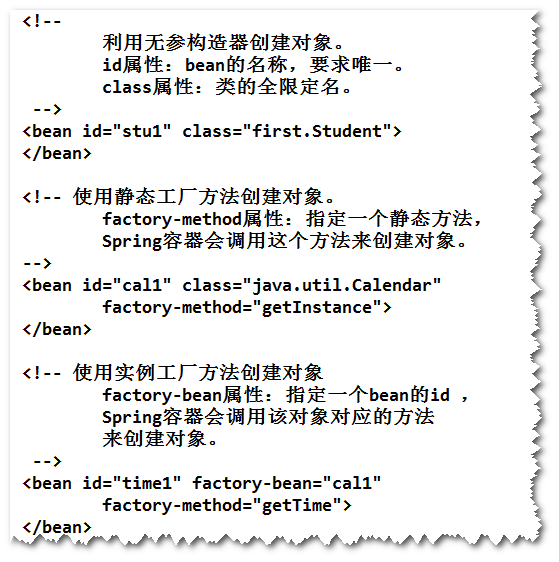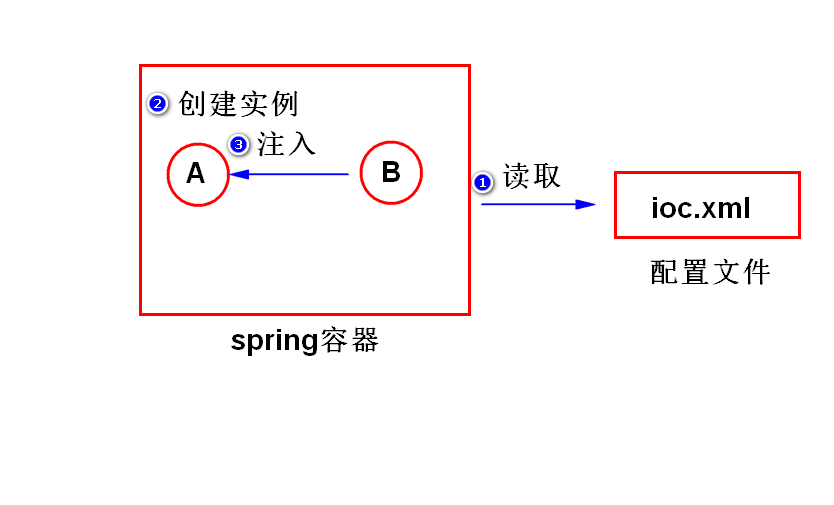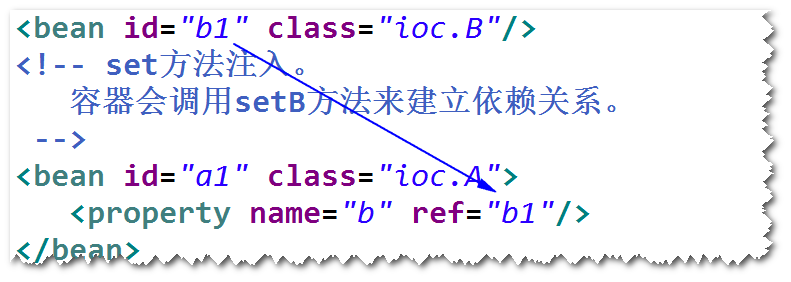Unit01: Spring简介 、 Spring容器 、 Spring IOC
Unit01: Spring简介 、 Spring容器 、 Spring IOC
Spring
(1)Spring是什么?
Spring是一个开源的用来简化应用开发的框架。
(2)Spring的特点?
简化开发
Spring对很多常用的api做了简化(比如,Spring对jdbc就做了很好的 封装,我们利用Springjdbc访问数据库,就不用考虑如何获取连接和关闭 连接)。
解耦
Spring帮我们管理对象之间的依赖关系,这样,便于代码的维护。
集成
Spring可以集成其它的一些框架。集成之后,这些框架的使用会变得 更加的简单。
(3)Spring容器
Spring容器是什么?
Spring框架当中的一个核心模块,用来管理对象。
如何启动Spring容器?
step1. 导包。
step2. 添加配置文件。
step3. 编写启动Spring容器的代码。
如何创建对象?
方式一 无参构造器
step1. 类应用提供无参构造器(或者缺省构造器)。
step2. 在配置文件当中,添加一个bean元素。
step3. 启动Spring容器,调用容器提供的getBean方法获得要创建的
对象。
方式二 静态工厂方法 (了解)
方式三 实例工厂方法 (了解)

生命周期的管理
初始化方法 :
(用于获取资源,只执行一次)。
销毁方法:
(用于释放资源,只执行一次)。
注意,销毁方法只有在作用域为singleton才起作用。
作用域
默认情况下,对于一个bean元素,容器只会创建一个对应的实例。
可以设置作用域为prototype(原型,多个实例)。
延迟加载 (了解)
默认情况下,当容器启动之后,会将所有作用域为单例的bean创建好。
lazy-init属性:如果值为true,表示延迟加载,即容器启动之后,不会立即创建该实例。
(4)IOC (Inversion Of Controll 控制反转)
什么是IOC?
对象之间的依赖关系由容器来建立。
什么是DI? (Dependency Injection 依赖注入)
容器通过调用set方法或者构造器来建立对象之间的依赖关系。
注: IOC是目标,而DI是手段。

依赖注入的两种方式
方式一 set方法。
step1. 添加set方法。

step2. 配置set方法注入。

代码演示:

依赖的Jar包:
<project xmlns="http://maven.apache.org/POM/4.0.0" xmlns:xsi="http://www.w3.org/2001/XMLSchema-instance" xsi:schemaLocation="http://maven.apache.org/POM/4.0.0 http://maven.apache.org/xsd/maven-4.0.0.xsd">
<modelVersion>4.0.0</modelVersion>
<groupId>com.tarena.spring</groupId>
<artifactId>spring-day01</artifactId>
<version>0.0.1-SNAPSHOT</version>
<packaging>war</packaging>
<dependencies>
<dependency>
<groupId>org.springframework</groupId>
<artifactId>spring-webmvc</artifactId>
<version>3.2.8.RELEASE</version>
</dependency>
<dependency>
<groupId>junit</groupId>
<artifactId>junit</artifactId>
<version>4.12</version>
</dependency>
</dependencies>
</project>
pom.xml
src/main/java/
basic
package basic;
public class MessageBean {
public MessageBean() {
System.out.println("MessageBean()");
}
public void init(){
System.out.println("init()");
}
public void sendMsg(){
System.out.println("sendMsg()");
}
public void destroy(){
System.out.println("destroy()");
}
}
MessageBean.java
package basic;
public class ScopeBean {
public ScopeBean() {
System.out.println("ScopeBean()");
}
}
ScopeBean.java
first
package first; import java.util.Calendar;
import java.util.Date; import org.springframework.context.ApplicationContext;
import org.springframework.context.support.ClassPathXmlApplicationContext; public class FirstSpring { public static void main(String[] args) {
//step1. 启动Spring容器
/*
* ClassPathXmlApplicationContext
* 会依据类路径查找配置文件。
*/
ApplicationContext ac =
new ClassPathXmlApplicationContext(
"applicationContext.xml");
//System.out.println(ac);
//step2. 通过容器,获得对象。
Student stu1 =
ac.getBean("stu1",Student.class);
System.out.println(stu1); Date date1 =
ac.getBean("date1",Date.class);
System.out.println(date1); Calendar cal1 =
ac.getBean("cal1",Calendar.class);
System.out.println("cal1:" + cal1); Date time1 =
ac.getBean("time1",Date.class);
System.out.println("time1:" + time1);
} }
FirstSpring.java
package first;
public class Student {
public Student() {
System.out.println("Student()");
}
}
Student.java
ioc
package ioc;
public class A {
private B b;
public void setB(B b) {
System.out.println("A's setB()");
this.b = b;
}
public A() {
System.out.println("A()");
}
public void service(){
System.out.println("A's service()");
//调用B的f1()方法
b.f1();
}
}
A.java
package ioc;
public class B {
public B() {
System.out.println("B()");
}
public void f1(){
System.out.println("B's f1()");
}
}
B.java
src/main/resource
<?xml version="1.0" encoding="UTF-8"?>
<beans xmlns="http://www.springframework.org/schema/beans"
xmlns:xsi="http://www.w3.org/2001/XMLSchema-instance"
xmlns:context="http://www.springframework.org/schema/context"
xmlns:jdbc="http://www.springframework.org/schema/jdbc"
xmlns:jee="http://www.springframework.org/schema/jee"
xmlns:tx="http://www.springframework.org/schema/tx"
xmlns:aop="http://www.springframework.org/schema/aop"
xmlns:mvc="http://www.springframework.org/schema/mvc"
xmlns:util="http://www.springframework.org/schema/util"
xmlns:jpa="http://www.springframework.org/schema/data/jpa"
xsi:schemaLocation="
http://www.springframework.org/schema/beans http://www.springframework.org/schema/beans/spring-beans-3.2.xsd
http://www.springframework.org/schema/context http://www.springframework.org/schema/context/spring-context-3.2.xsd
http://www.springframework.org/schema/jdbc http://www.springframework.org/schema/jdbc/spring-jdbc-3.2.xsd
http://www.springframework.org/schema/jee http://www.springframework.org/schema/jee/spring-jee-3.2.xsd
http://www.springframework.org/schema/tx http://www.springframework.org/schema/tx/spring-tx-3.2.xsd
http://www.springframework.org/schema/data/jpa http://www.springframework.org/schema/data/jpa/spring-jpa-1.3.xsd
http://www.springframework.org/schema/aop http://www.springframework.org/schema/aop/spring-aop-3.2.xsd
http://www.springframework.org/schema/mvc http://www.springframework.org/schema/mvc/spring-mvc-3.2.xsd
http://www.springframework.org/schema/util http://www.springframework.org/schema/util/spring-util-3.2.xsd">
<!--
利用无参构造器创建对象。
id属性:bean的名称,要求唯一。
class属性:类的全限定名。
-->
<bean id="stu1" class="first.Student">
</bean> <bean id="date1" class="java.util.Date">
</bean> <!-- 使用静态工厂方法创建对象。
factory-method属性:指定一个静态方法,
Spring容器会调用这个方法来创建对象。
-->
<bean id="cal1" class="java.util.Calendar"
factory-method="getInstance">
</bean> <!-- 使用实例工厂方法创建对象
factory-bean属性:指定一个bean的id ,
Spring容器会调用该对象对应的方法
来创建对象。
-->
<bean id="time1" factory-bean="cal1"
factory-method="getTime">
</bean> </beans>
applicationContext.xml
<?xml version="1.0" encoding="UTF-8"?>
<beans xmlns="http://www.springframework.org/schema/beans"
xmlns:xsi="http://www.w3.org/2001/XMLSchema-instance"
xmlns:context="http://www.springframework.org/schema/context"
xmlns:jdbc="http://www.springframework.org/schema/jdbc"
xmlns:jee="http://www.springframework.org/schema/jee"
xmlns:tx="http://www.springframework.org/schema/tx"
xmlns:aop="http://www.springframework.org/schema/aop"
xmlns:mvc="http://www.springframework.org/schema/mvc"
xmlns:util="http://www.springframework.org/schema/util"
xmlns:jpa="http://www.springframework.org/schema/data/jpa"
xsi:schemaLocation="
http://www.springframework.org/schema/beans http://www.springframework.org/schema/beans/spring-beans-3.2.xsd
http://www.springframework.org/schema/context http://www.springframework.org/schema/context/spring-context-3.2.xsd
http://www.springframework.org/schema/jdbc http://www.springframework.org/schema/jdbc/spring-jdbc-3.2.xsd
http://www.springframework.org/schema/jee http://www.springframework.org/schema/jee/spring-jee-3.2.xsd
http://www.springframework.org/schema/tx http://www.springframework.org/schema/tx/spring-tx-3.2.xsd
http://www.springframework.org/schema/data/jpa http://www.springframework.org/schema/data/jpa/spring-jpa-1.3.xsd
http://www.springframework.org/schema/aop http://www.springframework.org/schema/aop/spring-aop-3.2.xsd
http://www.springframework.org/schema/mvc http://www.springframework.org/schema/mvc/spring-mvc-3.2.xsd
http://www.springframework.org/schema/util http://www.springframework.org/schema/util/spring-util-3.2.xsd">
<!--
init-method属性:指定初始化方法。
destroy-method属性:指定销毁方法。
lazy-init属性:如果值为true,表示延迟加载,
即容器启动之后,不会立即创建该实例。
-->
<bean id="mb1" class="basic.MessageBean"
init-method="init"
destroy-method="destroy"
lazy-init="true">
</bean> <!--
scope属性:指定作用域,缺省值是
singleton(单例,即单个实例);
可以设置作用域为prototype(原型,多个实例)。
-->
<bean id="sb1" class="basic.ScopeBean"
scope="prototype">
</bean> </beans>
basic.java
<?xml version="1.0" encoding="UTF-8"?>
<beans xmlns="http://www.springframework.org/schema/beans"
xmlns:xsi="http://www.w3.org/2001/XMLSchema-instance"
xmlns:context="http://www.springframework.org/schema/context"
xmlns:jdbc="http://www.springframework.org/schema/jdbc"
xmlns:jee="http://www.springframework.org/schema/jee"
xmlns:tx="http://www.springframework.org/schema/tx"
xmlns:aop="http://www.springframework.org/schema/aop"
xmlns:mvc="http://www.springframework.org/schema/mvc"
xmlns:util="http://www.springframework.org/schema/util"
xmlns:jpa="http://www.springframework.org/schema/data/jpa"
xsi:schemaLocation="
http://www.springframework.org/schema/beans http://www.springframework.org/schema/beans/spring-beans-3.2.xsd
http://www.springframework.org/schema/context http://www.springframework.org/schema/context/spring-context-3.2.xsd
http://www.springframework.org/schema/jdbc http://www.springframework.org/schema/jdbc/spring-jdbc-3.2.xsd
http://www.springframework.org/schema/jee http://www.springframework.org/schema/jee/spring-jee-3.2.xsd
http://www.springframework.org/schema/tx http://www.springframework.org/schema/tx/spring-tx-3.2.xsd
http://www.springframework.org/schema/data/jpa http://www.springframework.org/schema/data/jpa/spring-jpa-1.3.xsd
http://www.springframework.org/schema/aop http://www.springframework.org/schema/aop/spring-aop-3.2.xsd
http://www.springframework.org/schema/mvc http://www.springframework.org/schema/mvc/spring-mvc-3.2.xsd
http://www.springframework.org/schema/util http://www.springframework.org/schema/util/spring-util-3.2.xsd">
<bean id="b1" class="ioc.B"/>
<!-- set方法注入。
容器会调用setB方法来建立依赖关系。
-->
<bean id="a1" class="ioc.A">
<property name="b" ref="b1"/>
</bean> </beans>
ioc.xml
src/test/java
test
package test; import org.junit.Test;
import org.springframework.context.ApplicationContext;
import org.springframework.context.support.AbstractApplicationContext;
import org.springframework.context.support.ClassPathXmlApplicationContext; import basic.MessageBean;
import basic.ScopeBean;
import ioc.A; public class TestCase {
@Test
//测试 初始化方法和销毁方法
public void test1(){
//启动spring容器
String config = "basic.xml";
/*
* ApplicationContext接口没有提供
* 关闭容器的方法。
*/
AbstractApplicationContext ac =
new ClassPathXmlApplicationContext(
config);
//通过容器获得对象
MessageBean mb1 =
ac.getBean("mb1",MessageBean.class);
mb1.sendMsg();
//关闭容器
ac.close();
} @Test
//测试 作用域
public void test2(){
//启动spring容器
String config = "basic.xml";
ApplicationContext ac =
new ClassPathXmlApplicationContext(
config);
ScopeBean sb1 =
ac.getBean("sb1",ScopeBean.class);
ScopeBean sb2 =
ac.getBean("sb1",ScopeBean.class);
System.out.println(sb1 == sb2); } @Test
//测试 延迟加载
public void test3(){
//启动spring容器
String config = "basic.xml";
ApplicationContext ac =
new ClassPathXmlApplicationContext(
config);
} @Test
//测试 依赖注入
public void test4(){
//启动spring容器
String config = "ioc.xml";
ApplicationContext ac =
new ClassPathXmlApplicationContext(
config);
A a1 =
ac.getBean("a1",A.class);
a1.service();
}
}
TestCase.java
下面是上面这个案例:ioc包下的方法升级版:
增加一个IB接口,B.java , C.java实现IB.java接口,实现f1()方法,能让A.java灵活调用B和C下的f1方法。
ioc
接口:
package ioc;
public interface IB {
public void f1();
}
IB.java
package ioc;
public class A {
private IB b;
public void setB(IB b) {
System.out.println("A's setB()");
this.b = b;
}
public A() {
System.out.println("A()");
}
public void service(){
System.out.println("A's service()");
//调用B的f1()方法
b.f1();
}
}
A.java
package ioc;
public class B implements IB{
public B() {
System.out.println("B()");
}
public void f1(){
System.out.println("B's f1()");
}
}
B.java
package ioc;
public class C implements IB{
public C() {
System.out.println("C()");
}
public void f1(){
System.out.println("C's f1()");
}
}
C.java
Unit01: Spring简介 、 Spring容器 、 Spring IOC的更多相关文章
- spring简介、容器、IOC
对IOC的理解: 在平时的java应用开发中,我们要实现某一个功能或者说是完成某个业务逻辑时至少需要两个或以上的对象来协作完成,在没有使用Spring的时候,每个对象在需要使用他的合作对象时,自己均要 ...
- [Spring学习笔记 1 ] Spring 简介,初步知识--Ioc容器详解 基本原理。
一.Spring Ioc容器详解(1) 20131105 1.一切都是Bean Bean可是一个字符串或者是数字,一般是一些业务组件. 粒度一般比较粗. 2.Bean的名称 xml配置文件中,id属性 ...
- 【Spring 1】Spring简介
一.Spring简介 首先,Spring框架是由于软件开发的复杂性而创建的.Spring使用的是基本的JavaBean来完成以前只可能由EJB完成的事情.然而,Spring的用途不仅仅限于服务器端的开 ...
- spring框架篇(一)-------spring简介与配置文件使用控制反转事例
spring简介 Spring 是一个开源框架,中文意思就是春天,也许是作者想让自己的这个框架给Java开发人员带来春天吧.其官方网站是 https://spring.io/ ,可以在官方网站下载到完 ...
- Spring简介即Spring Ioc
Spring框架简介 Spring是一个开源框架,Spring是于2003 年兴起的一个轻量级的Java 开发框架,由Rod Johnson 在其著作Expert One-On-One J2EE De ...
- 【Spring】IoC容器 - Spring Bean作用域Scope(含SpringCloud中的RefreshScope )
前言 上一章学习了[依赖来源],本章主要讨论SpringBean的作用域,我们这里讨论的Bean的作用域,很大程度都是默认只讨论依赖来源为[Spring BeanDefinition]的作用域,因为在 ...
- MyEclipse Spring 学习总结一 Spring IOC容器
一.Spring IOC容器---- Spring AllicationContext容器 程序的结构如下: 1.首先在MyEclipse 创建创建Java Project 2.创建好后,添加spin ...
- 【spring源码分析】IOC容器初始化(总结)
前言:在经过前面十二篇文章的分析,对bean的加载流程大致梳理清楚了.因为内容过多,因此需要进行一个小总结. 经过前面十二篇文章的漫长分析,终于将xml配置文件中的bean,转换成我们实际所需要的真正 ...
- 【spring源码分析】IOC容器初始化(二)
前言:在[spring源码分析]IOC容器初始化(一)文末中已经提出loadBeanDefinitions(DefaultListableBeanFactory)的重要性,本文将以此为切入点继续分析. ...
随机推荐
- Linux中awk后面的RS, ORS, FS, OFS 用法
Linux中awk后面的RS, ORS, FS, OFS 含义 一.RS 与 ORS 差在哪 我们经常会说,awk是基于行列操作文本的,但如何定义“行”呢?这就是RS的作用. 默认情况下,RS的 ...
- iptables(五)iptables匹配条件总结之二(常用扩展模块)
iprange扩展模块 之前我们已经总结过,在不使用任何扩展模块的情况下,使用-s选项或者-d选项即可匹配报文的源地址与目标地址,而且在指定IP地址时,可以同时指定多个IP地址,每个IP用" ...
- I/O复用服务器端+回声客户端
并发服务器的第二种实现方法:I/O复用 服务器端: #include <arpa/inet.h> #include <unistd.h> #include <algori ...
- 二十二、utl_inaddr(用于取得局域网或Internet环境中的主机名和IP地址)
1.概述 作用:用于取得局域网或Internet环境中的主机名和IP地址. 2.包的组成 1).get_host_name作用:用于取得指定IP地址所对应的主机名语法:utl_inaddr.get_h ...
- 过滤器(Filter)
1 什么是过滤器 过滤器JavaWeb三大组件之一,它与Servlet很相似!不它过滤器是用来拦截请求的,而不是处理请求的. 当用户请求某个Servlet时,会先执行部署在这个请求上的Filter,如 ...
- node 项目材料 集合
resfull 与 token node生成 跨平台 验证码图片 搭建简单的服务器
- 《Drools7.0.0.Final规则引擎教程》第4章 4.5RHS语法
RHS语法 使用说明 RHS是满足LHS条件之后进行后续处理部分的统称,该部分包含要执行的操作的列表信息.RHS主要用于处理结果,因此不建议在此部分再进行业务判断.如果必须要业务判断需要考虑规则设计的 ...
- jQuery插件实现表格隔行换色且感应鼠标高亮行变色
实现表格隔行换色,且感应鼠标行变色的方法有很多,在本文将为大家介绍的是使用jQuery插件来实现,具体如下 看代码: : css代码:
- 编程之美Ex2——字符串移位包含的问题
给定两个字符串s1,s2,要求判定s2是否能够被s1做循环移位得到的字符串包含. 例如, 给定s1=AABCD和s2=CDAA,返回true: 给定s1=ABCD和s2=ACBD,返回false. 法 ...
- 微信网页登录Tips
http://www.ruanyifeng.com/blog/2014/05/oauth_2_0.html 以这篇文章为例,一般都是用户在第三方app中登录时,由第三方去申请资源服务器的登录权限等.即 ...
